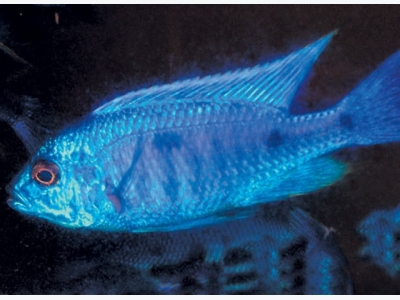Why aquaculture is stressful for fish

Fish species that are adapted for rivers generally perform better under aquaculture’s challenging conditions.
Fish in Africa’s Great Lakes, such as this Copadichromis azureus, are brightly coloured to facilitate mate recognition in a competitive, yet stable, environment. Photo: Nicholas James
Fish housed in aquaculture systems live under stressful conditions. This may come as a surprise to those who pride themselves on having provided ‘optimal’ conditions for their fish to grow and thrive.
However, if you have an understanding of the biology of fish, you will realise how false this perception can be.
Riverine fish
Most freshwater aquaculture species (tilapia, carp, trout, and salmon) originate in rivers, with very few coming from large stable lakes.
Riverine fish live in harsh environments. Rivers undergo natural cycles where floods, droughts, water chemistry, and turbidity all change rapidly.
Following a thunderstorm, water temperature can drop by as much as 5°C in a very short period, while at the same time, clear water can become highly turbid. The influx of rainwater can also rapidly change the chemistry of the water, with pH or salinity levels declining significantly.
Fish in these rivers have evolved with these changes; indeed, they thrive in them. Carp tolerate a wide range of temperatures and turbidity, while tilapia, trout and salmon cope with widely varying levels of salinity.
All these species are opportunistic feeders, which means they can take advantage of a temporary abundance of a particular food organism, such as newly hatched flying ants.
Fish farmers, in contrast, try to prevent rapid changes in their carefully controlled systems. Stocking densities are usually several orders of magnitude higher than in nature, so the fish can never find refuge, and there is constant competition for food.
Feed materialises only two to three times daily, which places stress on species such as tilapia and carp that feed almost continuously in nature.
Also, most species feed on a wide range of nutritious organisms found in recesses and open spaces in the wild. Contrast this with the closed structures made of non-natural materials found on a fish farm, and the ration of dry pellets.
Food is by no means the only difference. Oxygen levels are usually lower on a fish farm, and toxic ammonia levels are higher. In addition, the fish face the stress of being caught, graded, moved, and sorted from tank to tank.
All this adds up to a scenario far removed from the wild environment. It is to these riverine species’ credit that they perform so well under domesticated conditions.
Lacustrine fish
In general, fish from large, stable lakes tend to struggle under artificial mass-rearing conditions. The reason for this is that they have evolved in surroundings that change little, and their environmental tolerances, therefore, tend to be narrow.
For example, unlike their riverine cousins, Rift Lake cichlids produce a few, carefully guarded offspring in a competitive environment, rather than scattering thousands of eggs so that a few can survive.
Even lacustrine tilapia are very different from riverine tilapia species. They are slower growing, with lower reproductive output, and narrower feeding and environmental tolerances.
Related news
 Weighing the risks of farming non-native fish species in India
Weighing the risks of farming non-native fish species in India The culture of some species such as pangasius (Pangasianodon hypoththalmus), Nile tilapia (Oreochromis niloticus), red-bellied pacu (Piaractus brachypomus)
 Near-infrared spectrometers determine stage maturity in channel catfish
Near-infrared spectrometers determine stage maturity in channel catfish Most fish do not reproduce readily under captive conditions because environmental conditions necessary for reproduction are not well understood.
 Comparing nutritional values of wild and farmed whitefish
Comparing nutritional values of wild and farmed whitefish The aquaculture industry is unique among animal agriculture industries in that there is a near-equal amount of wild-harvested and farmed seafood